![]()
|
|
|
|
|
|
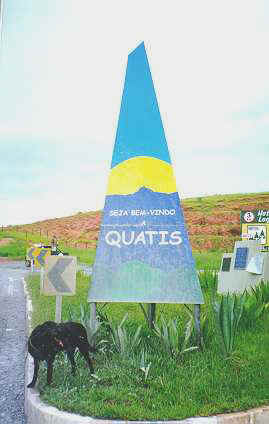
|
"I finally arrived in Quatis! " |
Originally inhabited by the Puris and AcarisIndians, our region took a lot of time to be explored, due to the geographical barrier of "Serra do Mar" (Sea Mountain). Only in 1724, under the order of Luiz Monteiro, the Governor, with the purpose of opening a shorter road to São Paulo, without the inconveniences of the marine crossing to Parati.
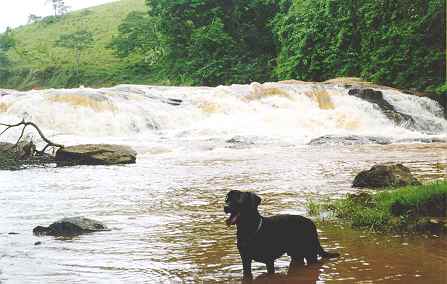
| "This is Cici Waterfall, about 8 km of dirt road from downtown" |
But only in the 18th century this region started to be conquered, coinciding with the decline of the gold cycle of Minas Gerais. Thereafter countless land areas were granted, due to the coffee cycle beginning. On the area of the current municipal district, in 1820, there were two important farms.
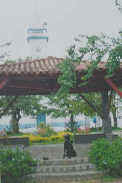
|
"That is the bandstand of the city" |
The formation of the first town, is especially thanks to Faustino Pinheiro, prosperous farmer of that time, who donated a land area, in 1832, for it under the condition that there, at the Crossroads of Quatis, it was raised a chapel in honor to "Nossa Senhora do Rosário". Then the name of the municipal district comes, because the place was inhabited by that species (Quati is an animal. You can see a picture of it in the trip to "Ponta Grossa", here on TripToBrazil). The fact that the district has grown around of that church, it determined a culture particularly impregnated by religious manifestations.
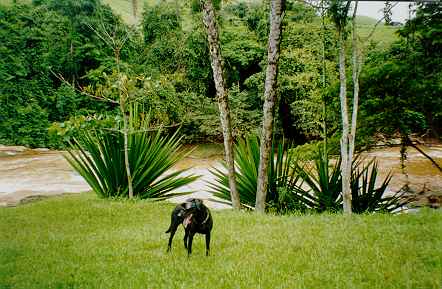
|
"Many nice views! " |
In 1897, the first school, "Ateneu Quatiense" was founded and the electric power was inaugurated.
The conclusion, in 1915, of the passage of "Oeste de Minas" Railway, almost crossing the whole district towards Minas Gerais, resulted on many settlers' and farmers' arrival from that State, for acquisition of coffee plantations, changing a lot of times the farming activities for the livestock.
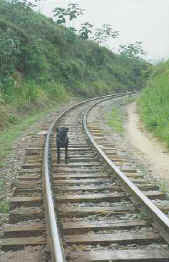
|
"A huge train passes here! " |
Around 1950, Falcão bus company, with a bus line that, at first, connected Falcão to Barra Mansa, going by Quatis. Still on this year, the first hospital was inaugurated by the Protection and Attendance to the Maternity and to the Childhood Association of Quatis.
Only in 1958 the pavement of the main street was made, "Nossa Senhora do Rosário" Street. In 1963, the "Minas Gerais Train" reaches its peak, that connected Quatis to Andrelândia, with daily trips, very sought by students from Resende, Porto Real, Quatis, Barra Mansa and Volta Redonda that decided to spend the weekend in the cities of the south of Minas. One of the best attractions of the trip was the restaurant of the train, where it was served the typical cheese from Minas and goodies of the area. Quatis stayed as district for 158 years, when in 1990, through a popular plebiscite, it was emancipated, together with two other districts of Barra Mansa: Falcão and Ribeirão de São Joaquim. The ordinance, that created one of the newest municipal districts of the State, is from January 09, 1991.
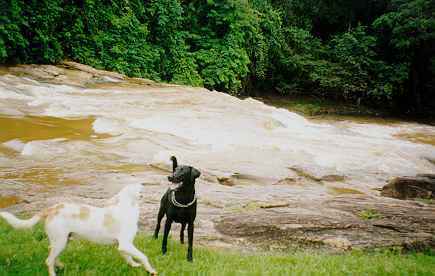
|
"I made a friend... " |
The municipal district is located to the south of the State of Rio de Janeiro, more specifically at Paraíba do Sul River's Valley and it makes boundary with Resende, Barra Mansa and Valencia, in the State of Rio de Janeiro and Passa Vinte, in the State of Minas Gerais.
At 127 Km from the capital and 270 Km from the city of São Paulo, through Dutra highway, it has a total area of 286,9 Km2 and average altitude of 415 m in relation to the sea.
"Paraíba do Sul" (South Paraíba) River is the receiver of the whole water mass of the municipal district. The river structure is characterized by the great amount of streams perpendicular to Paraíba do Sul river. Ribeirão das Pedras, Ribeirão Vermelho and Preto rivers stand out.
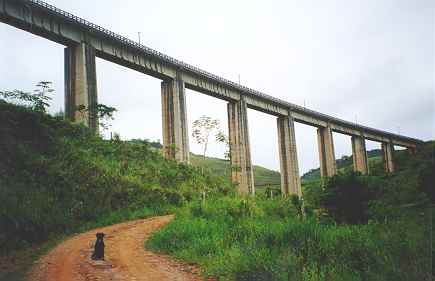
|
"I think it is possible to basejump from that viaduct... " |
Quatis is an land of dry climate, nice temperature and soft winds. A place that enchants those who get to know it, mainly for its natural beauties and for its people. Known by the parties and folklore, the municipal district also has the famous "Biquinha" (Waterspout), source of mineral water, with therapeutic properties.
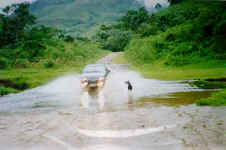
With its colonial architecture from the 18th century, preserved, especially in the districts of Ribeirão de São Joaquim and Falcão, Quatis provides to their visitors a trip to the past, in addition, they can still enjoy swimming in the rivers, waterfalls and rapids, mainly in Turvo and Preto Rivers, at the boundary with Minas Gerais, where walks and rustic trips, found man to nature.
"Feira da Roça" (Country Fair) is another attraction. Promoted all 2nd and 4th Sunday of every month, it gathers craft, country products and typical foods. The place counts with children park, restaurant and horses for rent.
We can highlight about tourist points, besides the already mentioned: Rural festivity and the famous rural cavalcades and trails with utilitarian and motorcycles; Cici Waterfall; Paca River Waterfall and Preto River rapids.
Visit Quatis is good for the eyes and the body
|
Tips by GUSTAVO VIVACQUA |
|
1. To get to Cici Waterfall, you have to ask for permission for the owner of the farm. 2. There are cell phone signal and public phones in the city. |
CLICK HERE to send your tip
CLICK HERE TO SEE OTHER BRAZILIAN DESTINATIONS